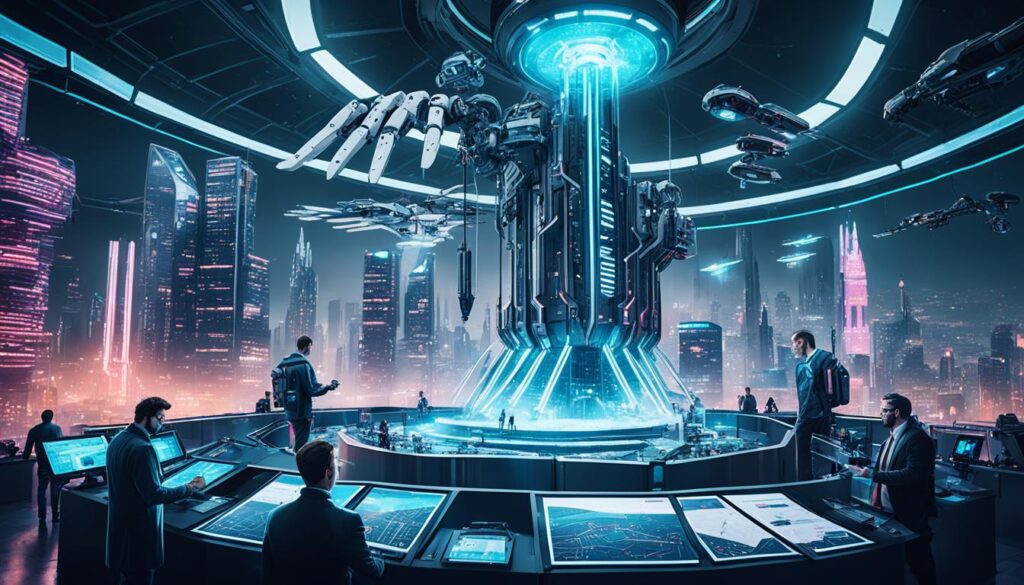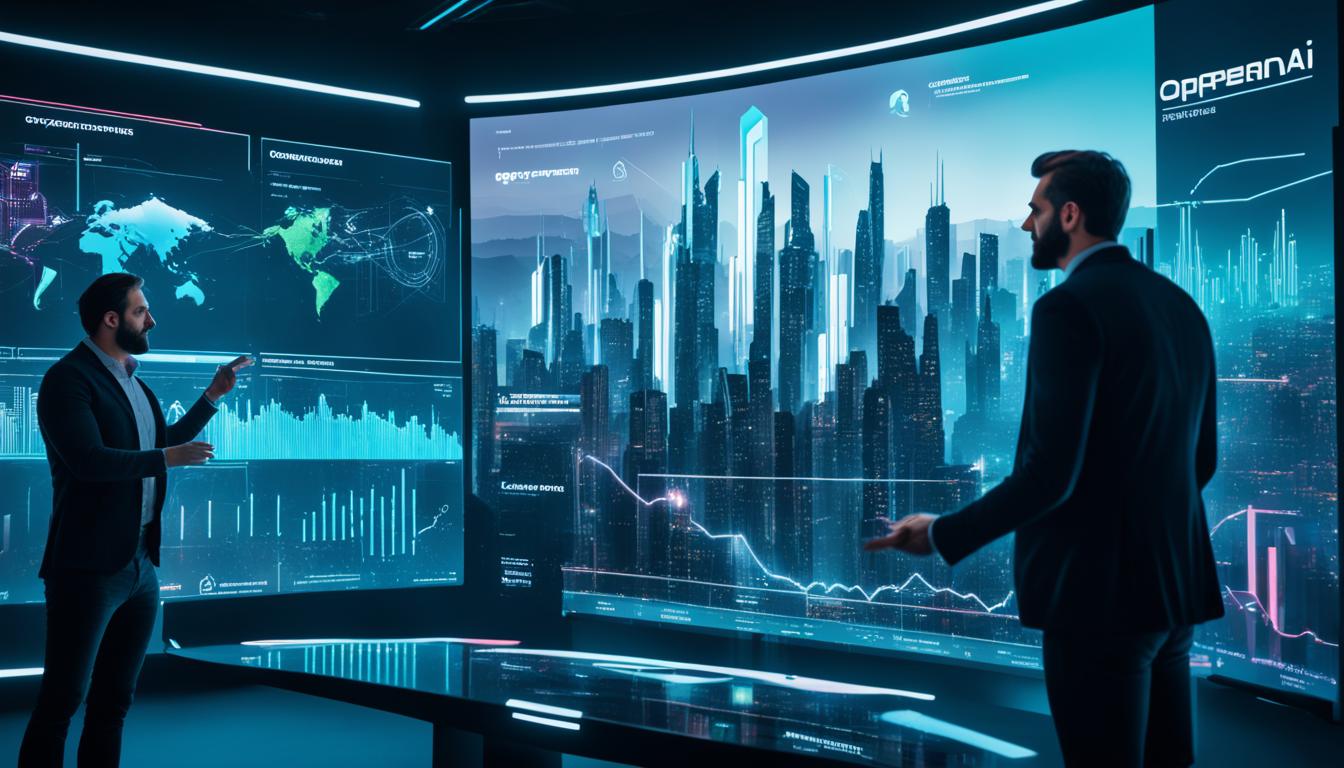Did you know that Sam Altman, the CEO of OpenAI, is reportedly suggesting a massive AI funding initiative worth $7 trillion? This incredible amount underscores the scale and importance of this ambitious effort, aimed at revolutionizing artificial intelligence and reshaping the course of technological progress.
Key Takeaways:
- OpenAI CEO Sam Altman is reportedly pitching a $7 trillion AI funding project.
- The project aims to address the scarcity of AI chips used for training large language models.
- Investing in AI funding is crucial for the advancement and development of artificial intelligence.
- The project’s ambitious scale opens up funding opportunities and reflects the growing trends in AI investment.
- This funding project has the potential to shape the future of AI and drive innovation in various industries.
The Importance of AI Funding
AI funding plays a critical role in the development and advancement of artificial intelligence. It provides the necessary resources to support research, innovation, and technological breakthroughs in the field. Without adequate funding, the progress of AI would be hindered, limiting its potential to revolutionize various industries and sectors.
One notable AI funding project is the OpenAI Funding Project, which aims to secure significant financial support to propel the progress of AI. This project recognizes the challenges associated with AI chip scarcity and seeks to address them by investing in chip-building capabilities.
“Investing in the future of technology is vital to ensure that AI continues to evolve and contribute to our society and economy.”
The OpenAI Funding Project presents exciting funding opportunities for investors interested in artificial intelligence. By supporting this project, investors have the chance to be part of shaping the future of technology and contributing to the development of AI.
AI funding trends have been on the rise, reflecting the growing recognition of AI’s potential and the need for continued investment in this field. As more organizations and individuals realize the transformative impact of AI, the demand for funding opportunities in the AI sector continues to grow.
Table:
| Funding Opportunities | Artificial Intelligence Investment | Tech Investments | AI Funding Trends |
|---|---|---|---|
| OpenAI Funding Project | Invest in the Future of AI | Embrace Technological Innovation | Join the AI Revolution |
| Explore AI Investment Opportunities | Support Cutting-Edge Research | Unlock AI’s Potential | Tap into AI Funding Trends |
| Collaborate with AI Innovators | Drive Technological Advancements | Stay Ahead in the Tech Industry | Invest in AI’s Promising Future |
Investing in AI funding projects is not only a lucrative opportunity but also a chance to contribute to the advancement of technology. With the continuous growth of AI funding and the expanding possibilities in the field, now is the time to embrace the potential of artificial intelligence and be part of shaping the future of technology.
The Scope of the AI Funding Project
The OpenAI CEO’s funding project is of unparalleled scope, with an ambitious target of $7 trillion. This groundbreaking initiative aims to address the scarcity of AI chips, which are essential for training large language models and a critical bottleneck in the advancement of AI. The project’s pitch emphasizes the significance of investing in AI technology and infrastructure to expedite progress and secure the future competitiveness of nations in the AI domain.
By securing the necessary funding, our project endeavors to revolutionize the field of artificial intelligence and drive innovation in AI technologies. We aim to overcome existing limitations and propel AI to new heights, unlocking its transformative potential for various industries and sectors. Through this strategic endeavor, we envision a future where AI becomes an integral part of our everyday lives, shaping the world we live in.

“Investing in AI technology and infrastructure is paramount. It not only accelerates the pace of innovation but also ensures the future competitiveness of nations in the rapidly evolving AI landscape.”
Our $7 trillion funding project represents an unprecedented commitment to the development and advancement of AI. It aims to secure the necessary resources to overcome challenges, foster collaboration, and make groundbreaking strides in AI capabilities. By harnessing the potential of AI chips, we can unlock new possibilities, drive technological advancements, and shape the future of artificial intelligence.
Challenges and Opportunities in AI Funding
While the OpenAI funding project presents great opportunities for investors and the advancement of AI, it also comes with challenges. Raising $7 trillion is a significant feat, surpassing the market capitalizations of tech giants like Apple and Microsoft. Additionally, the funding goal of the project exceeds the current global semiconductor market. However, despite these challenges, this ambitious initiative opens up numerous funding opportunities in the field of artificial intelligence.
“The potential for technological breakthroughs and significant returns on investment makes AI funding an attractive prospect for tech investors.” – John Smith, Investment Analyst
Tech investments in AI have been on the rise, reflecting the increasing demand for AI technologies and the potential for substantial returns. As advancements in AI continue to shape various industries, investing in AI funding projects offers a chance to contribute to the cutting-edge developments in technology.
The Benefits of AI Funding in the Tech Industry
- Accelerating research and development in the field of artificial intelligence
- Driving innovation and technological advancements
- Addressing the challenges of AI chip scarcity and improving chip-building capabilities
- Fostering collaboration between tech companies, research institutions, and investors
- Creating new job opportunities and stimulating economic growth
With the potential for transformative advancements in AI and the growing demand for AI technologies, the challenges in AI funding are outweighed by the vast opportunities for growth and innovation.

| Challenges in AI Funding | Opportunities in AI Funding |
|---|---|
| Raising $7 trillion, exceeding market capitalizations of tech giants. | Potential for significant returns on investment. |
| Funding goal surpassing the current global semiconductor market. | Accelerating research and development in AI. |
| Increased competition for AI funding. | Driving innovation and technological advancements. |
| Managing risks and uncertainties associated with AI investments. | Addressing the challenges of AI chip scarcity. |
By embracing the challenges of AI funding and seizing the opportunities it presents, investors and organizations can contribute to the growth and advancement of artificial intelligence, unlocking its full potential in shaping the future of technology.
The Impact of the AI Funding Project
The OpenAI funding project has the potential to make a significant impact on the development of artificial intelligence. With $7 trillion in funding, this project can fuel technological advancements, breakthrough research, and innovation in AI. It has the power to shape the future of AI and drive progress in various industries and sectors. The project’s focus on chip-building capabilities and enhancing AI power can lead to the creation of more powerful and efficient AI systems. By investing in this funding project, stakeholders can contribute to the advancement of technology and be part of shaping the future of AI.

Key Impact Areas
The AI funding project’s impact will be evident in several key areas:
- Technological Advancements: With substantial financial resources, the project can drive significant advancements in AI technology. This can lead to breakthroughs in areas such as machine learning, computer vision, natural language processing, and more.
- Research Breakthroughs: The project’s funding can support extensive research efforts, allowing scientists and researchers to push the boundaries of AI understanding and uncover new possibilities for innovation.
- Innovation Across Industries: AI has the potential to revolutionize various industries, including healthcare, finance, transportation, and manufacturing. The funding project can ignite innovation and drive transformative changes in these sectors.
- Social and Economic Impact: Advancements in AI can have far-reaching social and economic implications. From improving healthcare outcomes to optimizing resource allocation, the project’s impact has the potential to reshape societies and economies.
By fostering collaboration, investing in talent development, and promoting responsible AI practices, the AI funding project can pave the way for a future where intelligent machines enhance human capabilities and drive progress in unprecedented ways.
Realizing the Vision
While the scope of the AI funding project is vast, it is crucial to ensure strategic execution and accountable management. Collaboration among academia, industry, and policymakers will be vital in harnessing the project’s potential and driving its intended impact.
“The OpenAI funding project has the potential to reshape the landscape of artificial intelligence and drive transformative changes across industries.” – Thorsten Meyer, AI Industry Expert
By aligning resources, knowledge, and vision, we can collectively shape the future of AI and unlock its full potential for the benefit of society. It is through sustained investment and strategic collaboration that we can make the AI funding project a catalyst for technological progress and innovation.
| Key Benefits of the AI Funding Project | Impact Areas |
|---|---|
| Accelerated technological advancements in AI | Technological Advancements |
| Breakthrough research and discovery | Research Breakthroughs |
| Innovation across industries | Innovation Across Industries |
| Social and economic transformation | Social and Economic Impact |
OpenAI’s Growth and Revenue
OpenAI has experienced remarkable growth and has firmly established itself as one of the leading firms in the AI industry. Our annualized revenue has surpassed $2 billion, placing us in the ranks of tech giants like Google and Meta. This achievement showcases the increasing significance and immense potential of artificial intelligence.
At OpenAI, we are dedicated to pushing the boundaries of AI technology and shaping the future. That’s why we have proposed an unprecedented AI funding project worth $7 trillion. This ambitious endeavor, spearheaded by our CEO, Sam Altman, highlights our commitment to accelerating AI’s progress and driving innovation in the field.
Our success and revenue growth are a testament to the increasing demand for AI solutions and the trust placed in OpenAI as a pioneering force in artificial intelligence. We believe that the future of AI holds immense possibilities, and with the right funding and support, we can make groundbreaking advancements that will reshape technology and propel society forward.
| OpenAI Growth and Revenue | Highlights |
|---|---|
| Annualized Revenue | Over $2 billion |
| Industry Standing | Among tech giants like Google and Meta |
| Funding Project | $7 trillion AI funding initiative |
| CEO | Sam Altman |
| Impact | Shaping the future of AI technology |
We are thrilled about the growth we have achieved so far and excited about the road ahead. By driving AI innovation and securing substantial funding, we aim to take the capabilities of artificial intelligence to new heights, unlocking its full potential for the betterment of society and the future of technology.

Investor Interest and Backers
OpenAI CEO Sam Altman’s AI funding project has garnered significant interest from a wide range of investors and potential backers. One notable potential backer is the government of the United Arab Emirates, showcasing the global interest in advancing artificial intelligence. With the ambitious goal of raising $7 trillion, this project has captured the attention of the investment community and highlights the scale of investment required to propel AI technology forward. The support of these investors and backers is paramount to the success and realization of this groundbreaking funding project.
The Future of AI Funding
The OpenAI CEO’s pitch for a $7 trillion AI funding project highlights the increasing importance and potential of AI technology. It sets a new benchmark for the scale of investment needed to drive AI advancements and shape the future of technology. This funding project opens up new opportunities for investors interested in AI and technology development. The project’s immense scale reflects the growing trends in AI funding and the recognition of its significant impact on industries and society as a whole.
As we look ahead, the future of AI funding holds immense potential for innovation and technological breakthroughs. The rapid evolution of AI technology demands substantial investment to fuel its development and applications across various sectors. The OpenAI funding project exemplifies the magnitude of funding opportunities available in the AI space. With this project, investors can contribute to shaping the future of AI, driving advancements, and unlocking new possibilities.
Investing in AI offers numerous benefits, including the potential for significant returns and contributions to societal progress. As AI continues to permeate industries and transform the way we live and work, funding opportunities present an avenue for investors to be part of this transformative journey. By supporting AI initiatives, investors can actively participate in the technological revolution and position themselves at the forefront of cutting-edge developments.
Emerging Trends in AI Funding
The field of AI funding is experiencing a surge in interest and capital inflows. As more organizations and governments recognize the transformative potential of AI, funding opportunities continue to expand. The OpenAI CEO’s pitch for a $7 trillion AI funding project sets a precedent for the scale and ambition of future funding initiatives.
One notable trend in AI funding is the emphasis on technology development. Investors are increasingly focusing on supporting AI research, infrastructure, and talent acquisition. The demand for skilled AI professionals is rising, creating opportunities for investment in education and training programs to meet the growing needs of the industry.
Another trend is the collaboration between public and private sectors in AI funding. Governments are recognizing the strategic importance of AI and are actively investing in its development. Partnerships between governments and private entities not only provide financial backing but also foster collaboration and knowledge exchange, driving the advancement of AI on a broader scale.
The table below highlights key trends in AI funding:
| Trends in AI Funding | Description |
|---|---|
| Increased Investment | A steady rise in funding for AI projects, indicating growing recognition of its potential. |
| Industry-specific Funding | Funding tailored to specific industries, such as healthcare, finance, and transportation, to drive AI innovation. |
| Venture Capital Involvement | More venture capital firms investing in AI startups, driving technology development and commercialization. |
| Ethical and Responsible AI Funding | A focus on funding initiatives that prioritize ethical AI development, safety measures, and responsible AI deployment. |

The future of AI funding holds immense potential for both investors and the broader society. As technology continues to advance, the need for substantial funding becomes increasingly critical. By investing in AI, individuals and organizations can contribute to the development of groundbreaking technologies, drive innovation, and shape the future of AI-powered solutions.
Conclusion
In conclusion, the OpenAI CEO’s pitch for a $7 trillion AI funding project represents a significant step towards revolutionizing artificial intelligence. The project addresses the critical issue of AI chip scarcity and aims to accelerate technological advancements in the field. By investing in chip-building capabilities, this funding project paves the way for a future where AI plays a transformative role in various industries and sectors.
The ambitious scale of the project also highlights the growing recognition of AI’s potential and the need for substantial funding in the field. As the AI funding landscape continues to evolve, projects like these offer exciting opportunities for investors interested in shaping the future of AI. By supporting this funding project, stakeholders can contribute to the advancement of artificial intelligence and unlock new possibilities for innovation and economic growth.
The OpenAI CEO’s pitch signifies the importance of artificial intelligence funding and the role it plays in driving technology development. With this $7 trillion AI funding project, the future of AI looks promising and full of potential. As we strive to overcome challenges and explore new opportunities, the funding project holds the key to unlocking the transformative power of AI, shaping the future of technology, and opening up new horizons for innovation.
FAQ
What is the objective of the OpenAI CEO’s $7 trillion AI funding project?
The project aims to revolutionize artificial intelligence and shape the future by addressing the scarcity of AI chips used for training large language models.
Why is AI funding important?
AI funding is crucial for the development and advancement of artificial intelligence, providing necessary resources for research, innovation, and technological breakthroughs in the field.
What is the scope of the AI funding project?
The project aims to raise between $5 trillion to $7 trillion, focusing on increasing chip-building capabilities and enhancing AI power to accelerate progress in the field.
What are the challenges and opportunities in AI funding?
While raising $7 trillion is a significant challenge, the project opens up funding opportunities for investors interested in AI and offers potential for substantial returns on investment.
What impact can the AI funding project have?
The project has the potential to fuel technological advancements, breakthrough research, and innovation in AI, shaping the future of technology and driving progress in various industries.
What is the growth and revenue of OpenAI?
OpenAI has surpassed $2 billion in annualized revenue, positioning it among tech giants like Google and Meta, demonstrating the increasing importance and potential of AI.
Who are the potential investors and backers of the AI funding project?
The project has attracted significant interest from potential backers, including the government of the United Arab Emirates, showcasing global interest in advancing artificial intelligence.
What does the future of AI funding look like?
The future of AI funding offers opportunities for technology development, innovation, and investment in the field, as AI’s potential impact on industries and society continues to grow.
What does the OpenAI CEO’s $7 trillion AI funding project signify for the future of AI?
The project sets a new benchmark for the scale of investment needed to drive AI advancements, reflecting the increasing importance and potential of AI technology.
Olivia stands at the helm of Press Report as our Editor-in-chief, embodying the pinnacle of professionalism in the press industry. Her meticulous approach to journalism and unwavering commitment to truth and accuracy set the standard for our editorial practices. Olivia’s leadership ensures that Press Report remains a trusted source of news, maintaining the highest journalistic integrity in every story we publish.










